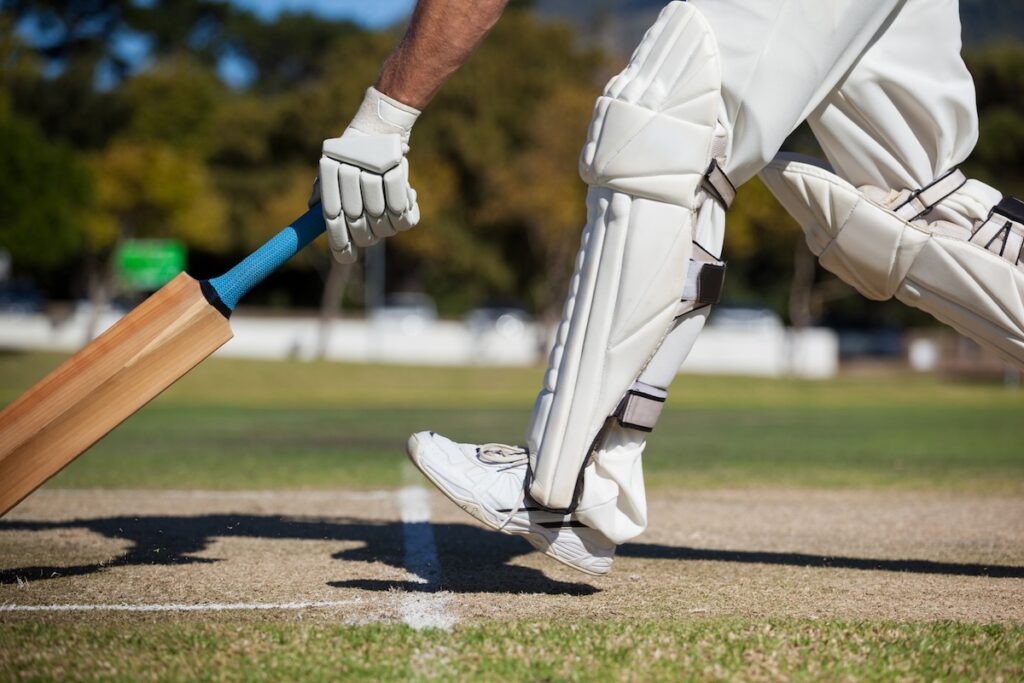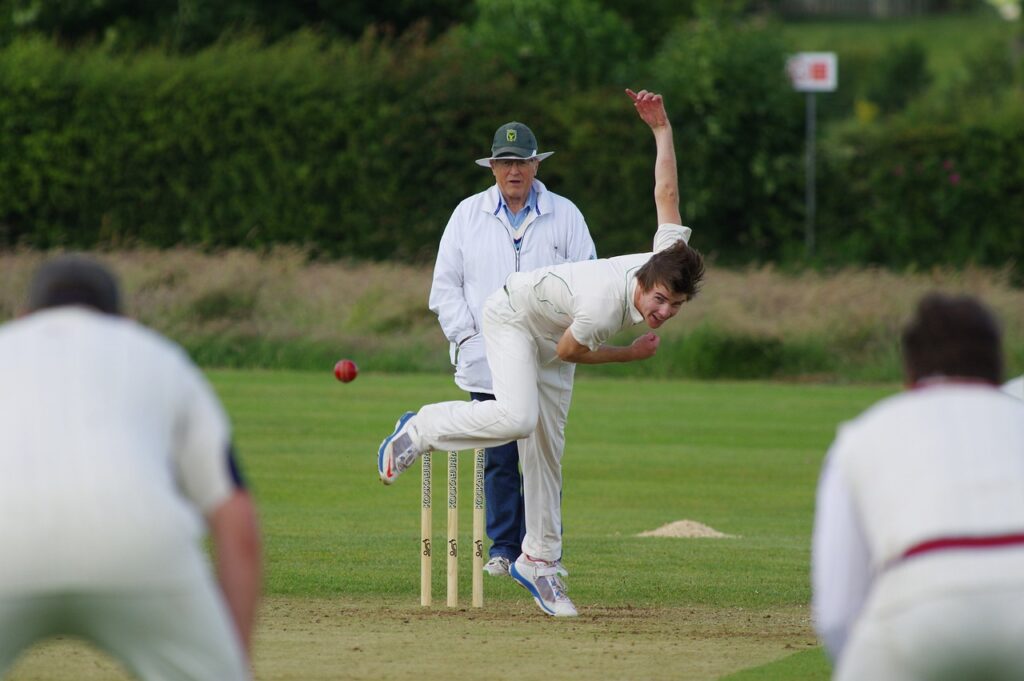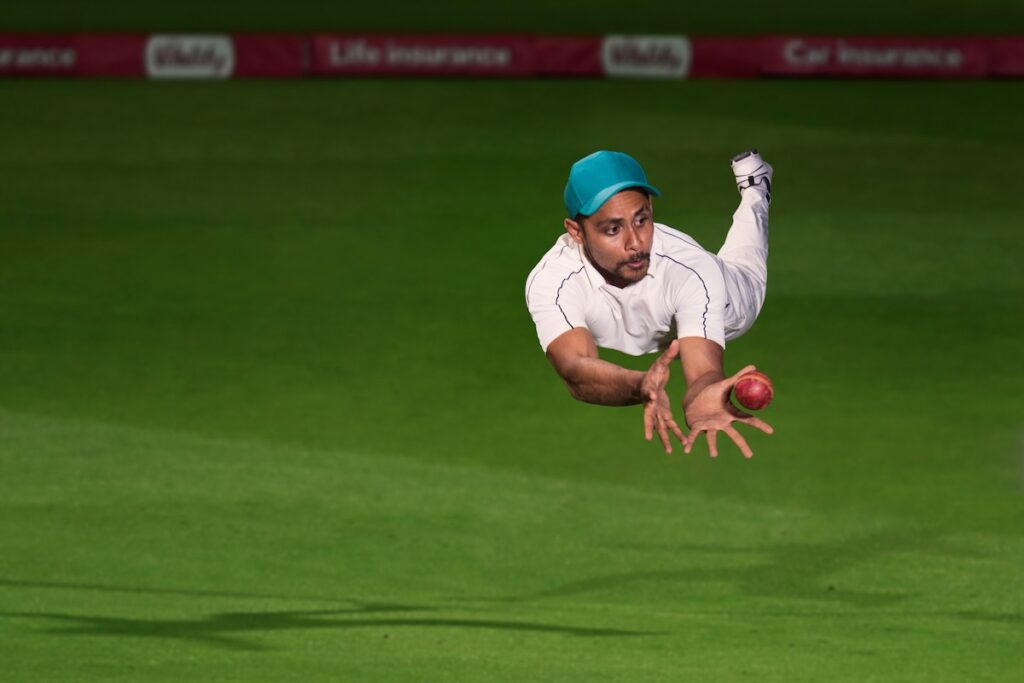
I hope you enjoy reading this blog post.
James Breese, Cricket Matters FounderIf you need my help with your cricket fitness, rehab, or nutrition needs, click here.
In my professional opinion, all cricketers should perform running workouts to improve their endurance.
Running is crucial for cricketers to improve their endurance, as it maintains physical fitness and enhances cognitive function during long matches.
Running and sprinting play a big part of the game. You have to practice it. Just like cricket, running is a skill.
That doesn’t mean running marathons; it just means being smart about how you do it.
Research has shown that regular endurance training can significantly improve mental sharpness and decision-making skills, which are crucial for cricket. (Goble & Christie, 2017).
This is because aerobic exercises, like running, increase blood and oxygen flow to the brain, which is vital for cognitive processes.
Increased endurance enables cricketers to maintain concentration and composure, facilitates quicker recovery between overs when bowling and running threes when batting, and helps them execute more strategic thought processes more effectively under pressure.
Moreover, studies indicate that cricketers who engage in regular endurance activities have better cognitive flexibility, which is essential for adapting to the dynamic nature of cricket, where quick thinking and strategic adjustments are crucial to performance and winning matches.
Therefore, cricketers who integrate running regularly into their training programs can expect increased stamina and a mental edge over their peers.
With that in mind, here are my favourite running workouts for cricketers to improve endurance.
Table of Contents
#1 The Aerobic Base Builder Workout

Cricketers’ viewing themselves as endurance athletes is beneficial, especially when considering the importance of aerobic base building.
Cricket is mostly a day-long sport for club cricketers and a multi-day sport for professionals.
Aerobic base building, particularly running at a sub-aerobic threshold or “zone 2,” is fundamental in developing a solid endurance foundation.
Running in this zone, where intensity is controlled to remain at a level that allows for conversation, optimizes fat burning and enhances mitochondrial density and cardiovascular efficiency without overstraining the body.
This effortless running style helps athletes sustain energy over long periods, which is crucial for cricket.
Training at a light intensity increases the body’s efficiency in using oxygen, decreases fatigue, and promotes recovery.
By regularly training in “Zone 2”, cricketers can improve their stamina and ability to recover faster.
The Workout
Don’t let this workout fool you.
It’s designed to be easy, and that’s how you build a strong endurance engine.
Cricketers should do this, particularly in the off-season (subject to injuries).
It’s not always all about doing workouts to failure. That’s just a recipe for burnout.
You should feel refreshed and energised at the end of these workouts, as if you could do them again.
Workout Notes
- The MAF method is preferred for calculating aerobic threshold (Zone 2 Training). Generally, your MAF heart rate is 180 minus your age. You’ll need a heart rate monitor or a smartwatch that shows your heart rate.
- If you do not have a heart rate monitor, run at a conversational pace you can easily maintain for the entire run.
- This is best performed in the off-season. For more advanced runners, it can be a light recovery run between weekend matches.
- Give yourself at least 48 hours of recovery between these types of workouts.
| Day 1 | Day 2 | |
| Weeks 1 – 2 | 30 Minutes @ MAF | 35 Minutes @ MAF |
| Weeks 3 – 4 | 40 Minutes @ MAF | 45 Minutes @ MAF |
| Weeks 5 – 6 | 50 Minutes @ MAF | 50 – 60 Minutes @ MAF |
| Weeks 7- 8 | 25 mins @MAF + Fast Finish: 5 Minutes @Moderate Intensity (RPE 7/10) | 25 mins @MAF + Fast Finish: 10 Minutes @Moderate Intensity (RPE 7/10) |
| Weeks 9 – 10 | 30 mins @MAF + Fast Finish: 10 Minutes @Moderate Intensity (RPE 7/10) | 35 mins @MAF + Fast Finish: 12 Minutes @Moderate Intensity (RPE 7/10) |
| Week 11 – 12 | 40 mins @MAF + Fast Finish: 12 Minutes @Moderate Intensity (RPE 7/10) | 45 mins @MAF + Fast Finish: 15 Minutes @Moderate Intensity (RPE 7/10) |
#2 The Batsman Shuttle Running Workout

This one is for the batsman in you.
I’d highly recommend doing this pre-season. However, in-season, if you only play one game weekly, I’d throw this in, too.
It will improve your stamina when running between the wickets. Still, more importantly, it will help you recover faster so you can concentrate on facing the next ball and making better decisions.
Batting is all about making good decisions, and the fitter you are, the better your decision-making process will be.
Workout Notes
- If you can’t access a cricket pitch, place two cones 22 yards apart.
- Perform this without pads and a bat.
- Use a heart rate monitor where possible. This will give you the most accurate recovery data.
- If you do not have a heart rate monitor or smartwatch, rest for 1 minute between shuttles.
- Leave 48 hours between these workouts for maximum recovery.
| Day 1 | Day 2 | |
| Weeks 1 – 2 | Set a Timer for 15 Minutes Run 1. Rest Until Heart Rate Drops < 120bpm Run 2: Rest Until Heart Rate Drops < 120bpm Run 3: Rest Until Heart Rate Drops < 120bpm Repeat for 15 Minutes. | Set a Timer for 20 Minutes Run 1. Rest Until Heart Rate Drops < 120bpm Run 2: Rest Until Heart Rate Drops < 120bpm Run 3: Rest Until Heart Rate Drops < 120bpm Repeat for 20 Minutes. |
| Weeks 3 – 4 | Set a Timer for 15 Minutes Run 2. Rest Until Heart Rate Drops < 120bpm Run 3: Rest Until Heart Rate Drops < 120bpm Repeat for 15 Minutes. | Set a Timer for 20 Minutes Run 2. Rest Until Heart Rate Drops < 120bpm Run 3: Rest Until Heart Rate Drops < 120bpm Repeat for 20 Minutes. |
| Weeks 5 – 6 | Set a Timer for 20 Minutes Run 3. Rest Until Heart Rate Drops < 120bpm Repeat for 20 Minutes. | Set a Timer for 25 Minutes Run 3. Rest Until Heart Rate Drops < 120bpm Repeat for 25 Minutes. |
Further Reading
#3 The Fast Bowler Running Workout

This is a workout for fast bowlers to improve bowling stamina and endurance.
In a One Day International (ODI) cricket match, fast bowlers cover a significant distance, averaging approximately 15.9 kilometres per game. (Petersen et al., 2009)
This total distance includes a variety of movements, with around 1.9 kilometres dedicated to high-intensity activities such as striding and sprinting, while the majority of the distance, about 10.9 kilometres, is covered by walking.
The average run-up speed is around 24km/h.
This highlights the immense physical demands placed on fast bowlers during a match, emphasising the importance of endurance and fitness in their performance.
With that in mind, these tempo runs are designed to improve endurance and technical proficiency for fast bowlers.
Workout Notes
- Set up two cones approximately 25m apart.
- I recommend performing this drill over wickets. These are mini hurdles that help improve technique and efficiency. Watch this video to learn more.
- Use a heart rate monitor where possible. This will give you the most accurate recovery data.
- If you do not have a heart rate monitor or smartwatch, rest for 1 minute between shuttles.
- Leave 48 hours between these workouts for maximum recovery.
- Perform off-season and pre-season. In mid-season, if you only play once weekly.
| Day 1 | Day 2 | |
| Weeks 1 – 2 | 8 – 10 Sets Run 25m @ 85%-90% Max Effort Walk Back to Start Rest Until Heart Rate Drops < 120bpm Repeat | 10 – 12 Sets Run 25m @ 85%-90% Max Effort Walk Back to Start Rest Until Heart Rate Drops < 120bpm Repeat |
| Weeks 3 – 4 | 12 – 15 Sets Run 25m @ 85%-90% Max Effort Walk Back to Start Rest Until Heart Rate Drops < 120bpm Repeat | 15 – 20 Sets Run 25m @ 85%-90% Max Effort Walk Back to Start Rest Until Heart Rate Drops < 120bpm Repeat |
| Weeks 5 – 6 | 20 – 25 Sets Run 25m @ 85%-90% Max Effort Walk Back to Start Rest Until Heart Rate Drops < 120bpm Repeat | 25 – 30 Sets Run 25m @ 85%-90% Max Effort Walk Back to Start Rest Until Heart Rate Drops < 120bpm Repeat |
#4 Fielding Running Workouts

Whether a batsman or a bowler, we all have to field, and fielding can be the difference between two equally matched sides.
Think about how often you have to sprint to the boundary in the game over varying distances.
From my experience, many drop catches happen when players who haven’t recovered in time have dropped concentration.
So, with that in mind, here’s a simple sprint endurance drill to help fielders improve their stamina when running to and from the boundary so that they can recover quicker and be ready to take that game-changing catch.
Workout Notes
- Mark out the distances as appropriate.
- Use a heart rate monitor where possible. This will give you the most accurate recovery data.
- If you do not have a heart rate monitor or smartwatch, rest for 1 minute between shuttles.
- Leave 48 hours between these workouts for maximum recovery.
- Perform off-season and pre-season. In mid-season, if you only play once weekly.
| Day 1 | Day 2 | |
| Weeks 1 – 2 | Round 1: 6 – 8 Sets Run 50 yards @ 85%-90% Max Effort Walk Back to Start Rest Until Heart Rate Drops < 120bpm Repeat Rest 3 – 5 Minutes Between Rounds Round 2: 3 – 4 Sets Run 100 yards @ 85%-90% Max Effort Walk Back to Start Rest Until Heart Rate Drops < 120bpm Repeat | Round 1: 6 – 8 Sets Run 25 yards @ 85%-90% Max Effort Walk Back to Start Rest Until Heart Rate Drops < 120bpm Repeat Rest 3 – 5 Minutes Between Rounds Round 2: 3 – 4 Sets Run 75 yards @ 85%-90% Max Effort Walk Back to Start Rest Until Heart Rate Drops < 120bpm Repeat |
| Weeks 3 – 4 | Round 1: 8 – 10 Sets Run 50 yards @ 85%-90% Max Effort Walk Back to Start Rest Until Heart Rate Drops < 120bpm Repeat Rest 3 – 5 Minutes Between Rounds Round 2: 4 – 6 Sets Run 100 yards @ 85%-90% Max Effort Walk Back to Start Rest Until Heart Rate Drops < 120bpm Repeat | Round 1: 8 – 10 Sets Run 25 yards @ 85%-90% Max Effort Walk Back to Start Rest Until Heart Rate Drops < 120bpm Repeat Rest 3 – 5 Minutes Between Rounds Round 2: 4 – 6 Sets Run 75 yards @ 85%-90% Max Effort Walk Back to Start Rest Until Heart Rate Drops < 120bpm Repeat |
| Weeks 5 – 6 | Round 1: 10 – 12 Sets Run 50 yards @ 85%-90% Max Effort Walk Back to Start Rest Until Heart Rate Drops < 120bpm Repeat Rest 3 – 5 Minutes Between Rounds Round 2: 6 – 8 Sets Run 100 yards @ 85%-90% Max Effort Walk Back to Start Rest Until Heart Rate Drops < 120bpm Repeat | Round 1: 10 – 12 Sets Run 25 yards @ 85%-90% Max Effort Walk Back to Start Rest Until Heart Rate Drops < 120bpm Repeat Rest 3 – 5 Minutes Between Rounds Round 2: 6 – 8 Sets Run 75 yards @ 85%-90% Max Effort Walk Back to Start Rest Until Heart Rate Drops < 120bpm Repeat |
Final Thoughts: Running Workouts for Cricketers

Running should be an essential component of a cricketer’s training arsenal.
It is vital for building and maintaining the endurance required to compete at the highest levels of the sport.
I’ve shared some structured running workouts to boost your physical stamina and enhance cognitive abilities, allowing cricketers to make sharper, quicker decisions under pressure.
Whether sprinting between the wickets, bowling long spells or fielding for hours on end, the endurance built through running ensures optimal performance, quick recovery, and mental alertness.
For cricketers aiming to improve their game, embracing running as a cornerstone of fitness training is not just beneficial—it’s essential.
Remember, the foundation of cricketing performance is not just the skill with the bat or ball but the endurance to outlast and outperform the opposition from the first over to the last.
If you need further assistance or a personalised approach to your training, don’t hesitate to schedule a strategy call with our team.
Further Reading
FAQs
Why Is Running Important for Cricketers?
Running is crucial for cricketers for several reasons. Firstly, it builds cardiovascular fitness, essential for maintaining stamina during long matches. Cricket often involves bursts of intense activity, such as sprinting between wickets or quick movements during fielding, followed by periods of less intense activity. Running helps cricketers sustain their energy levels throughout these phases. Secondly, running strengthens the leg muscles, enhancing agility and speed, which is vital for effective fielding and running between wickets. Lastly, running enhances lung capacity and endurance, allowing cricketers to perform at their peak for extended periods.
What Are the Benefits of Zone 2 Running for Cricketers?
Zone 2 running refers to exercising at a moderate intensity where you can converse comfortably but still work significantly. This level of exertion is particularly beneficial for cricketers for several reasons:
Improved Fat Oxidation: Training in this zone maximizes the body’s ability to burn fat as a fuel source, which is crucial for long-duration sports like cricket.
Increased Mitochondrial Density: Zone 2 running stimulates the production of new mitochondria in your cells, improving energy production and efficiency.
Better Aerobic Base: Consistent training in this zone enhances cardiovascular and respiratory health, providing a solid foundation for higher-intensity workouts.
Enhanced Recovery: Training in Zone 2 helps quicker recovery between matches.
Can Running Help Improve Decision-Making Skills in Cricketers?
Yes, running can significantly improve cricketers’ decision-making skills. Aerobic exercise, like running, increases blood and oxygen flow to the brain, boosting cognitive functions. Improved cardiovascular fitness from regular running can lead to better brain health, quicker problem-solving abilities, and faster decision-making processes. This is critical in cricket, where split-second decisions can dictate the outcome of a game. Enhanced cognitive function also helps maintain concentration and focus throughout the game, which is crucial for strategic execution.
How Does Running Impact Recovery Times During Matches?
Running plays a significant role in improving recovery times during cricket matches. Enhanced cardiovascular fitness means cricketers can recover quickly between overs, innings, and even consecutive match days. Regular running elevates the efficiency of the circulatory system, allowing for faster removal of metabolic wastes and more efficient delivery of oxygen and nutrients to tired muscles. This quicker recovery process enables players to maintain a higher level of performance for extended periods, essential in tournaments and longer game formats.
What Type of Running Workouts Are Best for Cricket Players?
The best types of running workouts for cricket players include a mix of long, slow runs, interval training, and sprint sessions:
Long Slow Runs: These enhance aerobic capacity and endurance, helping players maintain their performance levels throughout a long day of cricket.
Interval Training: This involves alternating between periods of high intensity and recovery. It’s excellent for improving aerobic and anaerobic fitness, mirroring the stop-start nature of cricket.
Sprints: Short bursts of high-intensity running improve speed and power, which is crucial for quick singles or saving boundaries in the field.
Incorporating these various forms of running into training routines ensures that cricketers can develop all aspects of their fitness, which is crucial for their performance on the field.



![[Case Study] Advanced Hiit Training Plan for Cricketers 5 Hiit Training for Cricketers](https://www.cricketmatters.com/wp-content/uploads/2024/04/HIIT_Training-1024x536.png)